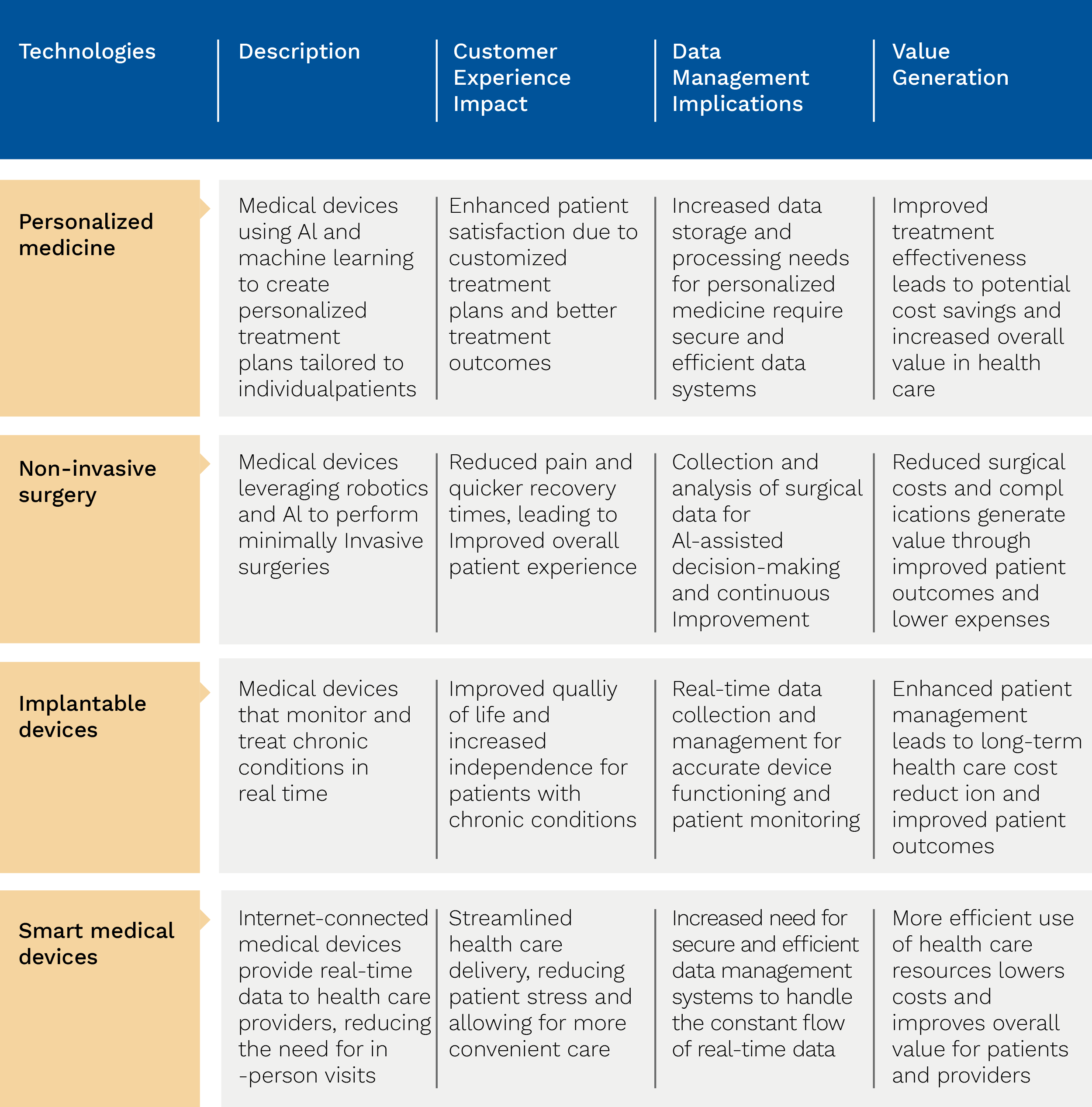Introduction
A medical device is a type of instrument or machine that is utilized for medical purposes such as diagnosis, and treatment of illness. According to reports, the global medical device industry will increase to $671.49 billion in 2027. Medical devices vary from simple tongue depressors and smart bandages to a broad range of complex and sophisticated machines such as imagining machines and hi-tech robots.
These devices are used in hospitals and clinics, helping medical professionals with diagnosis, giving treatment to patients for illness, and improving their quality of life. Now, let’s deep dive and discuss the role of medical devices in enhancing a patient’s journey, and what are the benefits of these medical devices. We will also talk about technologies that are revolutionizing medical devices.
Major Technologies That Are Changing the Game for Medical Devices
In the field of medical devices, technology remains to play a revolutionary part. Several cutting-edge technologies are influencing the future of medical device design. Here is a list of a few important technologies that have changed the healthcare industry:
- The Internet of Things (IoT) and Connected Medical Devices
The Internet of Things (IoT) has changed medical devices by providing seamless data sharing and communication. IoT-enabled medical device can provide real-time patient data to healthcare clinicians, that allows remote monitoring and data-driven choices.
Firmware and form factors are important concepts of Internet of Things (IoT) and connected medical devices as they help to minimize the equipment footprint. Here are two instances:
Firmware Optimization: The software that controls a device’s functions and is integrated into its hardware is known as firmware. Simplifying code, utilizing less memory, and increasing processing effectiveness are all part of optimizing firmware for IoT medical devices.
Form Factor Miniaturization: A device’s physical dimensions, form, and design are referred to as its form factor. Reducing the size of medical IoT devices while retaining their functionality is known as miniaturizing their form factor.
- Artificial Intelligence (AI) and Machine Learning (ML) Applications
Artificial Intelligence (AI) and Machine Learning (ML) have revolutionized the capabilities of medical equipment, empowering healthcare professionals like never before. By harnessing the power of these cutting-edge technologies, medical professionals can:
- Analyze vast amounts of data: AI and ML algorithms can process and interpret large databases efficiently.
- Uncover hidden patterns and trends: These technologies can identify correlations and insights that might otherwise go unnoticed.
- Generate accurate predictions: AI and ML models can provide precise forecasts based on historical data and real-time inputs.
As a result, AI-driven diagnostic tools and treatment recommendations are transforming the landscape of patient care. EdgeAI is such an example of deploying AI/ML capabilities on medical devices.
Developing EdgeAI based applications involves processing data locally on devices. Below are some examples of EdgeAI-
Diagnostic Imaging: Edge AI can analyze medical images such as X-rays, MRI scans, and CT scans in real time. It assists radiologists in detecting abnormalities, tumors, fractures, or other conditions.
Fall Detection and Elderly Care: Edge AI algorithms can be deployed in smart home devices or wearables to detect falls among elderly individuals. It alerts caregivers or emergency services and improves response times.
Drug Discovery and Development: Edge AI can accelerate drug discovery processes by analyzing vast chunks of data. It predicts drug interactions and identifies potential drug candidates.
- Smart Wearable and Sensors
Smart wearables medical devices come with different sensors. Some examples are heartbeat monitors and glucose sensors, which provide continuous health monitoring. They provide crucial information for customized medical care along with early disease identification.
Miniaturization has emerged as a significant trend in the development of smart wearables and sensors. This advancement allows manufacturers to:
- Integrate advanced features into compact devices
- Reduce the size and weight of wearables and sensors
- Enhance user comfort and convenience
- Robots in Surgical Process
Robotics has changed surgical operations, enabling them to be more precise and less intrusive. Surgical robots provide increased dexterity, 3D visualization, and tremor reduction, leading to better patient outcomes and speedier recovery.
To give surgeons an accurate and complete picture of the operating field, cameras used in robotic-based surgical procedures need to be controlled with precision. Robotic surgery uses a variety of camera control devices to make this process easier, such as voice commands, foot pedals, and a surgeon console.
- Virtual and Augmented Reality
VR simulations provide realistic, hands-on experiences for medical students, while AR overlays digital information onto real-world objects, enhancing anatomical understanding.
In patient care, VR creates immersive environments for relaxation during procedures, and AR assists surgeons by displaying vital data. Telemedicine and remote healthcare benefit from VR/AR, breaking geographical barriers and improving access to quality care.
As these technologies advance, they unlock new opportunities for innovation, efficiency, and patient-centered care in the medical device industry.
How Medical Devices Are Enhancing a Patient’s Journey?
Imagine a world where patients can receive personalized, efficient, and comfortable healthcare every step of the way. Thanks to the latest advancements in medical device technology, this vision is becoming a reality. From early diagnosis to treatment and recovery, innovative tools and processes are enhancing the patient journey like never before.
In the past, navigating the healthcare system could be a daunting and chaotic experience for patients. However, with the introduction of cutting-edge medical devices, patients can now benefit from streamlined, patient-centric care that prioritizes their well-being and comfort. Let’s explore how these game-changing tools and processes are revolutionizing the patient experience:
Less Rigorous Surgical Process
While performing surgeries, advanced medical devices play an important role in supporting surgeons to reduce the complexity of the procedure and the time. To have a better idea, consider a laparoscopic surgical scenario where the patient heals faster and achieves better results.
Laparoscopic surgery, also known as minimally invasive surgery, utilizes specialized instruments and a high-definition camera inserted through small incisions in the patient’s body. These advanced medical devices provide surgeons with enhanced visualization and precise control, allowing them to perform complex procedures with greater accuracy and efficiency.
Effective Diagnostic Devices
Cutting-edge medical devices aid in the early detection and identification of numerous medical diseases, which helps the doctor to start immediate medical care. In some cases where doctors are not able to identify the problem with the patient, they rely on medical devices for the accurate finding. For example, medical devices such as X-rays and CT scanning are very helpful in these scenarios.
To get a better perspective on how the healthcare industry has changed with the integration of IoT. How personalized care and drug safety have improved with connected medical devices. You can read a blog on how connected medical devices have improved healthcare services in an efficient way.
Keeping an Eye on Patient Remotely
With the help of medical devices, doctors are able to monitor the patient remotely and track several symptoms and illnesses including hypertension, diabetes, asthma etc. Before this, the patients had to go to the hospital for every medical need and wait for the results. Now, the patients feel more at ease in their surroundings with this process.
Improved Medication Administration
In some scenarios, where individuals are unable to swallow meals or are not receiving enough nutrition in their bodies. A medical device known as an infusion pump comes in handy to administer nourishment, fluids, and medications to the individual in need. This device can be programmed to give appropriate dose of medicine at a controlled rate over adjustable time intervals. Thus, this reduces the caretaker’s workload and allows more effective care.

How Hospitals Benefit From Medical Device Innovation
Medical devices are currently undergoing some of the most significant developments. Here are five ways hospitals can benefit from innovations in medical device technology.
- Before Time Diagnosis of the Disease
New medical devices allow for the early detection of severe conditions. Which enables doctors to offer medications to patients before their symptoms worsen or become more difficult to treat.
Some of these developments, such as genomic testing devices, are based on genetic advances. Doctors can utilize genetic markers in a patient’s DNA to forecast whether they are prone to develop certain chronic and hereditary illnesses.
Most hospitals have medical imaging technologies, such as MRIs. These technologies aid doctors in detecting anomalies in a patient’s body before they cause symptoms.
- Zero Hassle Doctor Visits
Telemedicine allows medical professionals to provide counsel and diagnosis to patients who are unable to meet with a doctor in person.
Telemedical devices help in increasing the reach of doctors to treat patients. This technology can be utilized to assist distant patients in receiving critical follow-up care, particularly when the healthcare center is far away. It is also suitable for underprivileged places where long-distance travel is expensive or impossible due to weather or destroyed infrastructure.
- Surgical Advancement with Telesurgery
Surgeons use telemedicine and surgical robots to perform medical procedures, allowing patients to obtain specialist care without having to travel
This technology has been here since the 2000s, but with the slow wireless speed there wasn’t much progress. 4G in robotic surgery was the major development, but it could not provide fast speed for telesurgery. New developments in robotic surgery, such as the integration of 5G technology, are making telesurgery more feasible. 5G networks offer data transmission speeds that are 100 times faster than those of 4G, enabling real-time communication and control between surgeons and surgical robots.
- Treating Complex Diseases
Medical technological advancements save lives, and pacemakers are one of them. Doctors use this to maintain hearts that beat out of rhythm by employing a small device that uses electrical currents to maintain it.
New pacemakers are less bulky, simpler to install, and more durable. As a result, patients’ health outcomes improve, and the likelihood of consequences with surgical insertion decreases.
Other medical devices including Digital Polymerase Chain Reaction (dPCR) systems, which detect the level of DNA or RNA in a sample are helpful in assisting doctors identifying unusual disorders.
How Do Medical Devices Assist In Lowering Healthcare Costs?
The expense of healthcare has undoubtedly risen in recent years because of chronic illness, aging populations, and so on. This predicament has left a lot of patients with an empty wallet and pressured them to have more money to maintain their health through continued therapy. Let’s look at the pointers on how medical devices can assist in lowering healthcare costs.
- Transferring Medical Care From a Clinical Environment to the Home
To reduce the high expenses related to the clinical setting is to shift treatment out of a medical facility and into the patient’s home. Technologies such as telehealth and data collecting via mobile apps are enabling home-based monitoring and therapy.
- Improved Management of Chronic Conditions
Conducting healthcare at home or through wearables can be viewed as a more effective means of problem management. These new techniques of care not only save money by keeping people out of the hospital, but they also provide additional benefits in the way of enhanced care.
- Lowering Expenses Upstream by Producing Less Expensive Devices
Decreasing the costs upfront during device manufacturing helps minimize downstream healthcare costs that are passed on to patients later.
This leads us to consider reimbursement, which, for device manufacturers, can be an important factor in device design.
Traditional strategies such as lower cost per part through larger volume production, waste elimination through fast methods, along with effective supply chain management continue to have a significant impact on device cost savings. How Medical Devices Are Improving Healthcare Outcomes
Bottomline
The medical device sector is quickly evolving, with important technological developments on the way that have the potential to transform healthcare delivery. Medical device technology offers considerable benefits, including the ability to enhance patient outcomes, reduce medical expenses, and tackle health disparities. To maintain long-term success, medical device companies have to keep investing in R&D, adapt to evolving market conditions, and emphasize patient safety.












